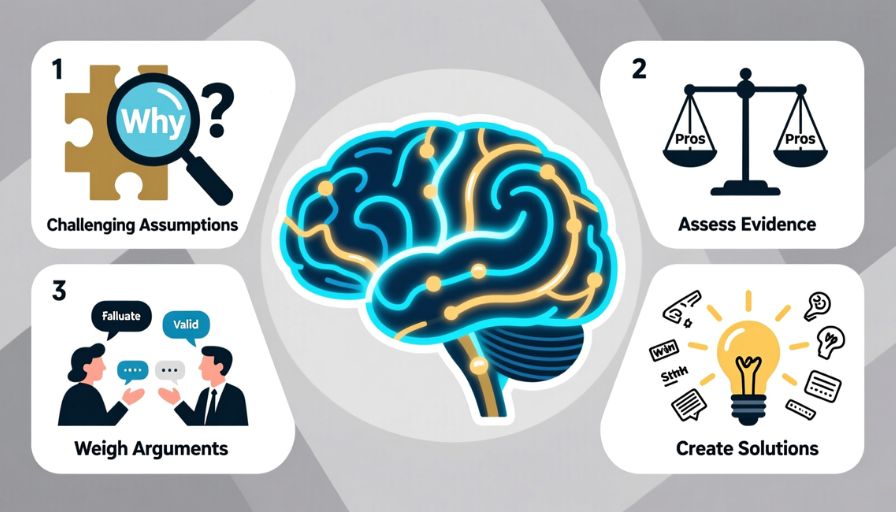In a world overflowing with information, the ability to think critically has become more important than ever. Critical thinking exercises are designed to sharpen your reasoning, challenge your assumptions, and help you make smarter decisions. Whether you are a student, professional, or lifelong learner, building strong critical thinking skills can completely change the way you approach problems and evaluate ideas.
What Are Critical Thinking Exercises?
Critical thinking exercises are mental challenges or activities that help individuals analyze situations, evaluate information, and draw logical conclusions. These exercises encourage deeper understanding instead of surface-level acceptance. From logical puzzles to reflective discussions, each activity trains your brain to question, reason, and decide more effectively.
Why Critical Thinking Matters
Critical thinking is not just about being skeptical or argumentative, it is about understanding situations from multiple perspectives. It allows you to separate facts from opinions and make decisions based on logic and evidence. In today’s fast-paced digital world, developing this skill is essential for success in education, business, leadership, and personal life.
- Better Decision-Making: It helps you analyze options and avoid impulsive judgments.
- Improved Problem-Solving: You can identify root causes rather than symptoms.
- Stronger Communication: You learn to explain your thoughts with clarity and evidence.
- Adaptability: It allows you to think creatively when faced with complex challenges.
Top Critical Thinking Exercises to Practice Daily
Here are some proven exercises that can strengthen your critical thinking skills and mental flexibility:
1. The “Five Whys” Technique
This exercise helps you dig deeper into the cause of a problem. Start with a simple question—why did this happen? Then ask “why” again five times. Each answer leads you closer to the root cause. This method is widely used in business and project management for problem-solving.
2. Analyze News Headlines
Pick a headline from any news outlet. Ask yourself: Who wrote this? What evidence is presented? Is there bias or missing information? This exercise helps you recognize manipulation in media and improve your information literacy.
3. The Socratic Questioning Method
Named after the philosopher Socrates, this exercise involves questioning every statement to explore underlying beliefs and assumptions. For example, when someone says, “That idea will never work,” ask “Why not?” and “What evidence supports that claim?” It builds logic and clarity.
4. Reverse Brainstorming
Instead of asking how to solve a problem, ask how to cause it. Once you understand how something fails, it becomes easier to identify solutions. This exercise promotes creative and lateral thinking.
5. Perspective Switching
Choose a topic or situation and argue it from multiple viewpoints, even ones you disagree with. This strengthens empathy, flexibility, and intellectual humility—key components of critical thinking.
6. Logic Puzzles and Strategy Games
Games like Sudoku, chess, or riddles train your brain to recognize patterns and anticipate outcomes. Regularly solving puzzles can improve your analytical and decision-making skills over time.
How to Incorporate Critical Thinking Into Daily Life
Critical thinking exercises work best when practiced consistently. Here are simple ways to include them in your everyday routine:
- Reflect on your day and identify moments where you made quick assumptions.
- Discuss topics with people who have different opinions to broaden your perspective.
- Read articles from multiple sources before forming an opinion.
- Journal about complex situations and question your own reasoning.
Critical Thinking in the Workplace
Employers across industries value employees who can think critically. It enables teams to assess risks, plan strategically, and solve problems efficiently. Practicing exercises like root-cause analysis, SWOT evaluation, and role-playing scenarios can enhance your professional decision-making.
Tips to Maximize the Results of Critical Thinking Exercises
- Be open-minded: Avoid defending your ideas automatically. Accept that you might be wrong.
- Challenge assumptions: Ask “what if” and “why” questions regularly.
- Stay curious: Curiosity drives deeper learning and understanding.
- Reflect often: Self-reflection helps you identify cognitive biases that influence your judgment.
Common Barriers to Critical Thinking
Many people struggle with critical thinking because of mental shortcuts or emotional biases. Confirmation bias, groupthink, and overconfidence often distort rational judgment. Recognizing these barriers is the first step toward overcoming them.
Final Thoughts
Critical thinking exercises are not just academic tools, they are life skills that empower you to think clearly, reason logically, and make sound decisions. By practicing these exercises daily, you can enhance your problem-solving ability, become a better communicator, and navigate the complexities of modern life with confidence.
Remember: Critical thinking is like a muscle, the more you train it, the stronger it gets.
